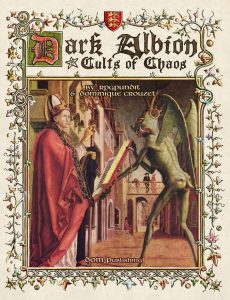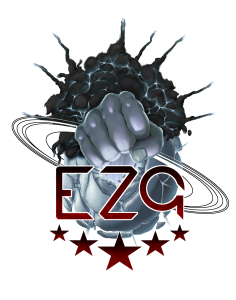Dark Albion: Cults of Chaos (OSR/FH&W) (Patreon Request)
Dark Albion: Cults of Chaos (OSR/FH&W)
This supplement clocks in at 94 pages, 1 page front cover, 1 page advertisement, 1 page editorial, 1 page introduction/ToC, 1 page SRD, leaving us with 89 pages of content, so let’s take a look!
I received this book in its Lulu softcover PoD-version by one of my readers for the purpose of a review, to be undertaken at my convenience. I also consulted the pdf version, but the review is primarily based on the print iteration.
Okay, so the first thing you need to know, is that this book is not necessarily Dark Albion-exclusive; the lion’s share of the book is not even OSR-exclusive; depending on your skills in the target system, you can use this with pretty much everything; there are rules-components here, but since the book does not subscribe to a singular OSR-system, much like Dark Albion, there might be some minor tweaks required when using this in some contexts. The book contains two pages of character sheets, and two pages of worksheets for the GM, which is certainly appreciated.
What is this book? In short: It’s the largest and most encompassing chaos cult generation toolkit I’ve seen so far. The generator operates in 7 simple steps: First, you determine the social class of the chaos cult – and yes, mixed cults are possible, but statistically are actually the rarest ones – which makes sense. Both of these come with tables. After this, you determine the size of the cult, and proceed with a simple decision: Has the cult been exposed or not (yet). Then, we come to the largest consideration – determine the cult type. Fake cults, witchcraft, old religions, heresies, elf cults, object cults, sex cults (PG 13, in case that bothers you) –here is the best thing about these: There are different cult types for different social classes: Nobles might e.g. follow immortality cults and the like. These cult types come btw. with more detailed descriptions.
In step 5, we get tables for cult secret lairs, once more with different tables for different social classes of the cults; step 6 is optional, but I’d recommend it: A massive table lets you determine special resources the cult might have – veterans, protection of local lords, monsters, etc. Also optional: Step 7 nets you a variety of chaos cult complications, with the table spanning 2.5 pages.
This generator alone is already an impressively potent tool for the GM, and from here, we only go further: We get tables to determine how cultists recognize each other, and a rather cool table on cultist obligations and taboos. Random tables for ceremonies are provided as well: One to determine the place, one for the required garb, and one to determine the ceremony type.
With these, an experienced GM already has the tools to make a cult adventure, but we haven’t started yet! The book then proceeds to present a wide array for actual reasons for joining a cult, which allows you to generate surprisingly plausible allegiances within the cult.
What’s that? You want CHAOS? Well, we have mutation rules here – in short: They are permanent and almost impossible to revert, which is how they should be; we learn about the church’s stance on mutation within Albion’s context (hint: It involves the words “kill” and “extreme” and “prejudice” and/or “pyre”…), before the book goes into a variety of mutations in 3 different categories: Minor, moderate, severe. Minor mutations can include witch marks, blood thirst, loss of hair, small horns, being worm-infested, etc. – is the fellow just diseased or a cultist? The fact that these are subtle is great – it lets you get into the witch-burning paranoia-mindset.
The major mutations are more rules-relevant and include being haunted, developing canines, loss of limbs or gaining the evil eye. Severe mutations, finally, include a familiar (with subtable including individual benefits), becoming fish men, green men, growing pincers, etc. These are the…well, nasty apotheosis kind of mutations that may see the target become the focus for a cult.
After these mighty generators, we get a step by step guide for running chaos cult adventures and potentially, even whole inquisition campaigns, with suggestions for current objectives, as well as a variety of really diverse hooks for getting into adventures; then clues. Get it? Now that the cult generator is done, the book proceeds to present a chaos cult adventure generator, and it’s a genuinely well-crafted one, including massive tables of clues to scavenge. This section btw. also include a means for players prodding in the dark to be rewarded, so if your players stumbled into an aspect of the adventure you have not accounted for, this’ll help.
The book then proceeds to depict, in detail, a massive array of tables for questioning NPCs: We get tables to randomly determine whether a random NPC is a cultist, how cultists and their allies will react, how non-cultists will react, and what non-cultists will tell. The book also features a total of 20 detailed baseless rumors – essentially detailed red herrings. Suggested events and encounters and a huge amount of sample cultist personalities, as well as a whole page of old-school statblocks for run-of-the-mill cultists are also featured.
This out of the way, we get a low-level, mid-level and high-level chaos cult dungeon – these come with nice b/w maps, and are functional; not brilliant, but they certainly do their job. No player-friendly versions of the maps are included. If the book has one weakness, it’s that the space taken up by these sample lair would have imho been better served by more material for the investigation generators.
Finally, since elves are chaotic and pretty evil in Dark Albion, we have notes on elf cults alongside a variety of different cults – from demonic cults to bacchae and good ole’ blood god we get detailed notes on daily practices, rituals, etc. There are notes for the heresy of the Cathari, Donatists, and there are notes for cults of Eros and Venus, Gaia, Green Man, etc. – and yes, Gnostics, Manichaeism, and the Hawk, deity of the Scots Men, Hecate, Mananan – this book delves deep into the whole aspect of mythology in Dark Albion that I’d have loved to see focused on more in the main book. And yes, frog cults are presented – but I have no problem with frog cults per se; I have a problem with the nation of high fantasy, decadent frog people breaking the setting’s consistence…so no problem there. We get appropriate notes like alien artifacts for star cults, magic item relevance, etc. – nice.
The final appendix of the book deals with locations of power, covering rules for magic-dampening locations and magic-enhancing ones; chaos-enhanced and planar-crossover locales, as well as a chaos backlash table can be found here – and since drugs are obviously involved in a pretty serious way in dubious rituals, the book covers a massive table of visions, hallucinations and bad trips, finishing what must be called a truly encompassing generator.
Conclusion:
Editing and formatting are very good on a formal and rules-language level, with everything being precise, didactically sound in sequence, etc. – no complaints. Layout adheres to a two-column b/w-standard, and is just as well-executed as in the campaign setting. Artworks are a mix of well-chosen public domain art and stock pieces; personally, I preferred the public domain art here. Cartography is nice and b/w, but there are no player-friendly iterations of the maps. Much to my dismay, the pdf has no bookmarks – if you just want that iteration, detract a star.
To get that straight from the get-go: This expansion/generator book is pretty darn awesome.
After the inconsistencies of the main book, this one focuses on dark fantasy themes and manages to depict chaos cults and making them in a holistic manner; it lets you not only create a cult, it also has all the tools to run an investigation into it in a pretty fluid manner, without much prep work. If you’re good at this type of thing/an experienced GM, you may well use this to run a spontaneous cult investigation sans any prep-work – heck, I’ve done it. That is a fantastic thing to achieve. RPG Pundit and Dominique Crouzet deliver in this book, big time. This is not only useful for Dark Albion, but far beyond the setting and system – whether WFRP, Greyhawk, The Witcher or some other dark fantasy setting, this can very much yield helpful results. An impressive achievement! 5 stars + seal of approval.
You can get this excellent cult-generator here on OBS!
If you’re enjoying my reviews, please consider leaving a donation, or joining my patreon here!


